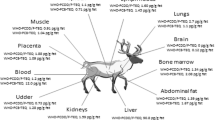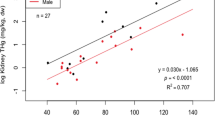Abstract.
According to previous experimental results, PCBs are deposited in muscle fat in animals and in humans, although they also reach the brain, the liver, and the lungs. The aim of the present study was to determine the concentrations of the so-called “indicator PCBs” (PCB nos. 28, 52, 101, 138, 153, 180), as described by the German ordinance for maximum concentrations of contaminants in foodstuffs, in muscle tissue, liver, and brain of four different species: fish, fox, roe deer, and humans, all exposed to PCBs directly in their environment. Potential target organs for the accumulation of these congeners were also to be identified. Furthermore, the organs or tissues were to be identified in which PCBs are accumulated, and unusual patterns of accumulation or breakdown of particular PCBs, for example the “dioxin-like PCBs” (coplanar PCBs) determined. For humans, the lungs were also included in these studies. Statistical comparison of PCB concentrations in samples from wild animals and humans showed that in spite of its relatively high fat concentration, brain tissue in all of the species examined (with the exception of fish) appeared to be better protected against accumulation of PCB than liver or muscle tissue. This protection may be the result of the blood-brain barrier, as witnessed by the relatively uniform concentration of PCBs throughout the various organs of fish, since the blood-brain barrier of fish is considerably less efficient than that of mammals. No peculiarities were found in regard to distribution of the coplanar PCBs over the other congeners in this study. This applies to the brain and other organs or tissues of the four species that were examined. Accumulations of PCBs and coplanar PCBs in the liver were only found in fox and roe deer. In contrast, humans were found to have accumulations of the high-chlorinated biphenyls studied here as well as PCB no. 118 in muscle tissue fat and not in the liver. Unexpectedly, low-chlorinated biphenyls were found to accumulate in the human lung. The results of this study show that the lung represents a target organ for the accumulation of potentially metabolically activated low-chlorinated biphenyls, indicating that the possible biological effects of PCBs on the lungs will need to receive more attention in the future.
Similar content being viewed by others
Author information
Authors and Affiliations
Additional information
Received: 16 January 1998/Accepted: 27 May 1998
Rights and permissions
About this article
Cite this article
Bachour, G., Failing, K., Georgii, S. et al. Species and Organ Dependence of PCB Contamination in Fish, Foxes, Roe Deer, and Humans. Arch. Environ. Contam. Toxicol. 35, 666–673 (1998). https://doi.org/10.1007/s002449900429
Issue Date:
DOI: https://doi.org/10.1007/s002449900429




